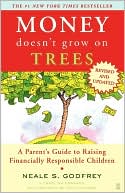List Books » Money Doesn't Grow on Trees: A Parent's Guide to Raising Financially Responsible Children
Category Books
- Fiction Books & Literature
- Graphic Novels
- Horror
- Mystery & Crime
- Poetry
- Romance Books
- Science Fiction & Fantasy
- Thrillers
- Westerns
- Ages 0-2
- Ages 3-5
- Ages 6-8
- Ages 9-12
- Teens
- Children's Books
- African Americans
- Antiques & Collectibles
- Art, Architecture & Photography
- Bibles & Bible Studies
- Biography
- Business Books
- Christianity
- Computer Books & Technology Books
- Cookbooks, Food & Wine
- Crafts & Hobbies Books
- Education & Teaching
- Engineering
- Entertainment
- Foreign Languages
- Game Books
- Gay & Lesbian
- Health Books, Diet & Fitness Books
- History
- Home & Garden
- Humor Books
- Judaism & Judaica
- Law
- Medical Books
- New Age & Spirituality
- Nonfiction
- Parenting & Family
- Pets
- Philosophy
- Political Books & Current Events Books
- Psychology & Psychotherapy
- Reference
- Religion Books
- Science & Nature
- Self Improvement
- Sex & Relationships
- Social Sciences
- Sports & Adventure
- Study Guides & Test Prep
- Travel
- True Crime
- Weddings
- Women's Studies
Money Doesn't Grow on Trees: A Parent's Guide to Raising Financially Responsible Children » (REV)

Authors: Neale S. Godfrey, Carolina Edwards, Tad Richards
ISBN-13: 9780743287807, ISBN-10: 0743287800
Format: Paperback
Publisher: Simon & Schuster Adult Publishing Group
Date Published: August 2006
Edition: REV
Author Biography: Neale S. Godfrey
Book Synopsis
At a time when kids have more debt and temptation than ever comes a completely revised and updated edition of the #1 New York Times bestseller on teaching children aged three to twenty about money
Money Doesn't Grow on Trees is the book that parents turn to when it comes to teaching their children about money. With 180,000 young adults between the ages of eighteen and twenty-four declaring bankruptcy last year and college students graduating with an average of $28,000 in debt, Neale S. Godfrey is the definitive expert on the subject and her time-tested advice is more important than ever.
Money Doesn't Grow on Trees offers exercises and concrete examples on everything from responsible budgeting to understanding the difference between "want" and "need" for children of every age. This revised edition includes entirely new sections that discuss
• The power of the Internet
• The tactics of television advertisers
• The world of eBay
Godfrey's years of experience as a mother and a financial expert make Money Doesn't Grow on Trees a book no responsible parent can afford to pass up.
Children's Literature
This revised, updated version of a book that trains parents how to raise financially self-reliant children is still a timely topic. Bankruptcy and debt are on the rise among young adults. Here one learns that a parent can guide children from the age of two through eighteen to instill in them good budgeting habits and financial savvy. Age-appropriate games, outings, and explanations about money are some of the training techniques. There are effective and fun tips on how and when to start allowances, to arrange chores, and to segregate expenses and savings. An important distinction is made between "work for pay" and unpaid work expected by all "Citizens of the Household." A distinction is also made between those things that are money-related and those that are strictly behavior-related. Problem-solving and problem-prevention techniques are included. For example, if a child gets into the habit of borrowing from savings, the money should be put into a bank or locked strongbox. Or, if an older offspring returns home or stays at home into adulthood, a lease arrangement should be set up. Specifics about consumer choices, compounding savings, bank accounts, investment options, taxes, and wills are touched upon. This is a lot of material. There is a glossary, which can be used to review the child's financial growth periodically. However, it is possible that the parent will need training even beyond this book to be a good guide to children. Both the parent and the child may need to learn together.
Table of Contents
Subjects

